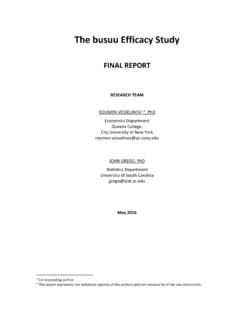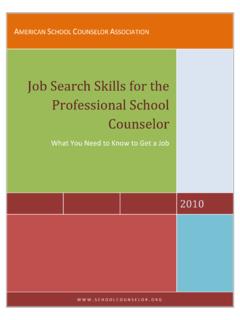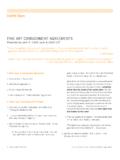Transcription of ABusiness Plan for a Startup Business
1 Page 1 of 31 Business plan for a Startup Business The Business plan consists of a narrative and several financial worksheets. The narrative template is the body of the Business plan . It contains more than 150 questions divided into several sections. Work through the sections in any order that you like, except for the Executive Summary, which should be done last. Skip any questions that do not apply to your type of Business . When you are finished writing your first draft, you ll have a collection of small essays on the various topics of the Business plan . Then you ll want to edit them into a smooth-flowing narrative. The real value of creating a Business plan is not in having the finished product in hand; rather, the value lies in the process of researching and thinking about your Business in a systematic way. The act of planning helps you to think things through thoroughly, study and research if you are not sure of the facts, and look at your ideas critically.
2 It takes time now, but avoids costly, perhaps disastrous, mistakes later. This Business plan is a generic model suitable for all types of businesses. However, you should modify it to suit your particular circumstances. Before you begin, review the section titled Refining the plan , found at the end. It suggests emphasizing certain areas depending upon your type of Business (manufacturing, retail, service, etc.). It also has tips for fine-tuning your plan to make an effective presentation to investors or bankers. If this is why you re creating your plan , pay particular attention to your writing style. You will be judged by the quality and appearance of your work as well as by your ideas. It typically takes several weeks to complete a good plan . Most of that time is spent in research and re-thinking your ideas and assumptions. But then, that s the value of the process.
3 So make time to do the job properly. Those who do never regret the effort. And finally, be sure to keep detailed notes on your sources of information and on the assumptions underlying your financial data. Page 2 of 31 Business plan OWNERS Your Business Name Address Line 1 Address Line 2 City, ST ZIP Code Telephone Fax E-Mail Page 3 of 31 I. Table of Contents I. Table of Contents .. 3 II. Executive Summary .. 4 III. General Company Description .. 5 IV. Products and 6 V. Marketing plan .. 7 VI. Operational plan .. 16 VII. Management and Organization .. 21 VIII. Personal Financial Statement .. 22 IX. Startup Expenses and Capitalization .. 23 X. Financial plan .. 24 XI. Appendices .. 27 XII. Refining the plan .. 28 Page 4 of 31 II. Executive Summary Write this section last. We suggest that you make it two pages or fewer.
4 Include everything that you would cover in a five-minute interview. Explain the fundamentals of the proposed Business : What will your product be? Who will your customers be? Who are the owners? What do you think the future holds for your Business and your industry? Make it enthusiastic, professional, complete, and concise. If applying for a loan, state clearly how much you want, precisely how you are going to use it, and how the money will make your Business more profitable, thereby ensuring repayment. Page 5 of 31 III. General Company Description What Business will you be in? What will you do? Mission Statement: Many companies have a brief mission statement, usually in 30 words or fewer, explaining their reason for being and their guiding principles. If you want to draft a mission statement, this is a good place to put it in the plan , followed by: Company Goals and Objectives: Goals are destinations where you want your Business to be.
5 Objectives are progress markers along the way to goal achievement. For example, a goal might be to have a healthy, successful company that is a leader in customer service and that has a loyal customer following. Objectives might be annual sales targets and some specific measures of customer satisfaction. Business Philosophy: What is important to you in Business ? To whom will you market your products? (State it briefly here you will do a more thorough explanation in the Marketing plan section). Describe your industry. Is it a growth industry? What changes do you foresee in the industry, short term and long term? How will your company be poised to take advantage of them? Describe your most important company strengths and core competencies. What factors will make the company succeed? What do you think your major competitive strengths will be?
6 What background experience, skills, and strengths do you personally bring to this new venture? Legal form of ownership: Sole proprietor, Partnership, Corporation, Limited liability corporation (LLC)? Why have you selected this form? Page 6 of 31 IV. Products and Services Describe in depth your products or services (technical specifications, drawings, photos, sales brochures, and other bulky items belong in Appendices). What factors will give you competitive advantages or disadvantages? Examples include level of quality or unique or proprietary features. What are the pricing, fee, or leasing structures of your products or services? Page 7 of 31 V. Marketing plan Market research - Why? No matter how good your product and your service, the venture cannot succeed without effective marketing. And this begins with careful, systematic research .
7 It is very dangerous to assume that you already know about your intended market. You need to do market research to make sure you re on track. Use the Business planning process as your opportunity to uncover data and to question your marketing efforts. Your time will be well spent. Market research - How? There are two kinds of market research : primary and secondary. Secondary research means using published information such as industry profiles, trade journals, newspapers, magazines, census data, and demographic profiles. This type of information is available in public libraries, industry associations, chambers of commerce, from vendors who sell to your industry, and from government agencies. Start with your local library. Most librarians are pleased to guide you through their Business data collection. You will be amazed at what is there.
8 There are more online sources than you could possibly use. Your chamber of commerce has good information on the local area. Trade associations and trade publications often have excellent industry-specific data. Primary research means gathering your own data. For example, you could do your own traffic count at a proposed location, use the yellow pages to identify competitors, and do surveys or focus-group interviews to learn about consumer preferences. Professional market research can be very costly, but there are many books that show small Business owners how to do effective research themselves. In your marketing plan , be as specific as possible; give statistics, numbers, and sources. The marketing plan will be the basis, later on, of the all-important sales projection. Economics Facts about your industry: What is the total size of your market?
9 Page 8 of 31 What percent share of the market will you have? (This is important only if you think you will be a major factor in the market.) Current demand in target market. Trends in target market growth trends, trends in consumer preferences, and trends in product development. Growth potential and opportunity for a Business of your size. What barriers to entry do you face in entering this market with your new company? Some typical barriers are: o High capital costs o High production costs o High marketing costs o Consumer acceptance and brand recognition o Training and skills o Unique technology and patents o Unions o Shipping costs o Tariff barriers and quotas And of course, how will you overcome the barriers? How could the following affect your company? o Change in technology o Change in government regulations o Change in the economy o Change in your industry Page 9 of 31 Product In the Products and Services section, you described your products and services as you see them.
10 Now describe them from your customers point of view. Features and Benefits List all of your major products or services. For each product or service: Describe the most important features. What is special about it? Describe the benefits. That is, what will the product do for the customer? Note the difference between features and benefits, and think about them. For example, a house that gives shelter and lasts a long time is made with certain materials and to a certain design; those are its features. Its benefits include pride of ownership, financial security, providing for the family, and inclusion in a neighborhood. You build features into your product so that you can sell the benefits. What after-sale services will you give? Some examples are delivery, warranty, service contracts, support, follow-up, and refund policy. Customers Identify your targeted customers, their characteristics, and their geographic locations, otherwise known as their demographics.







